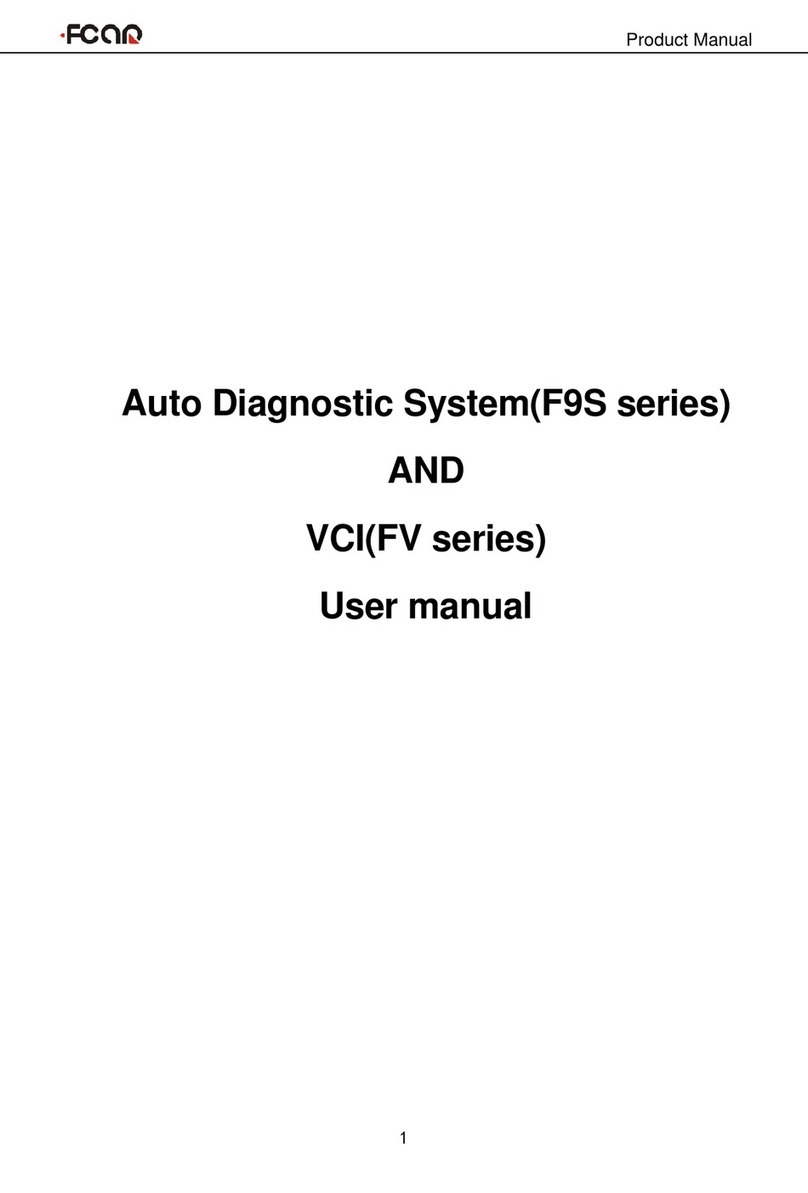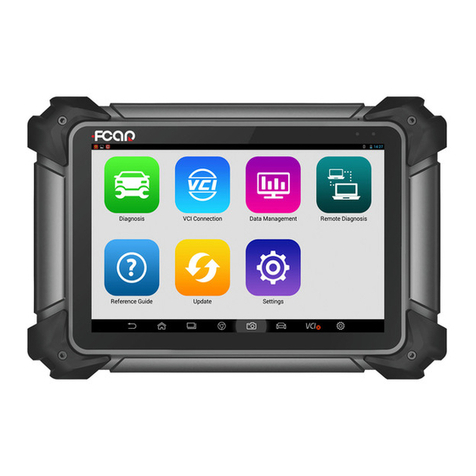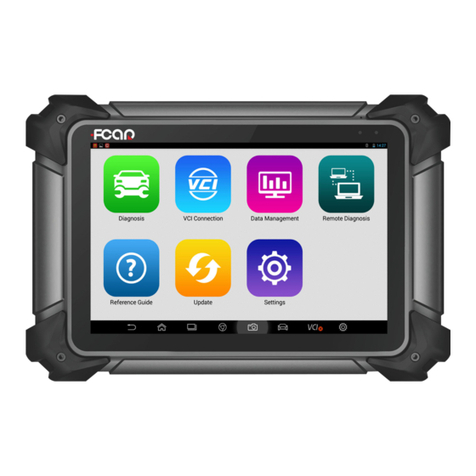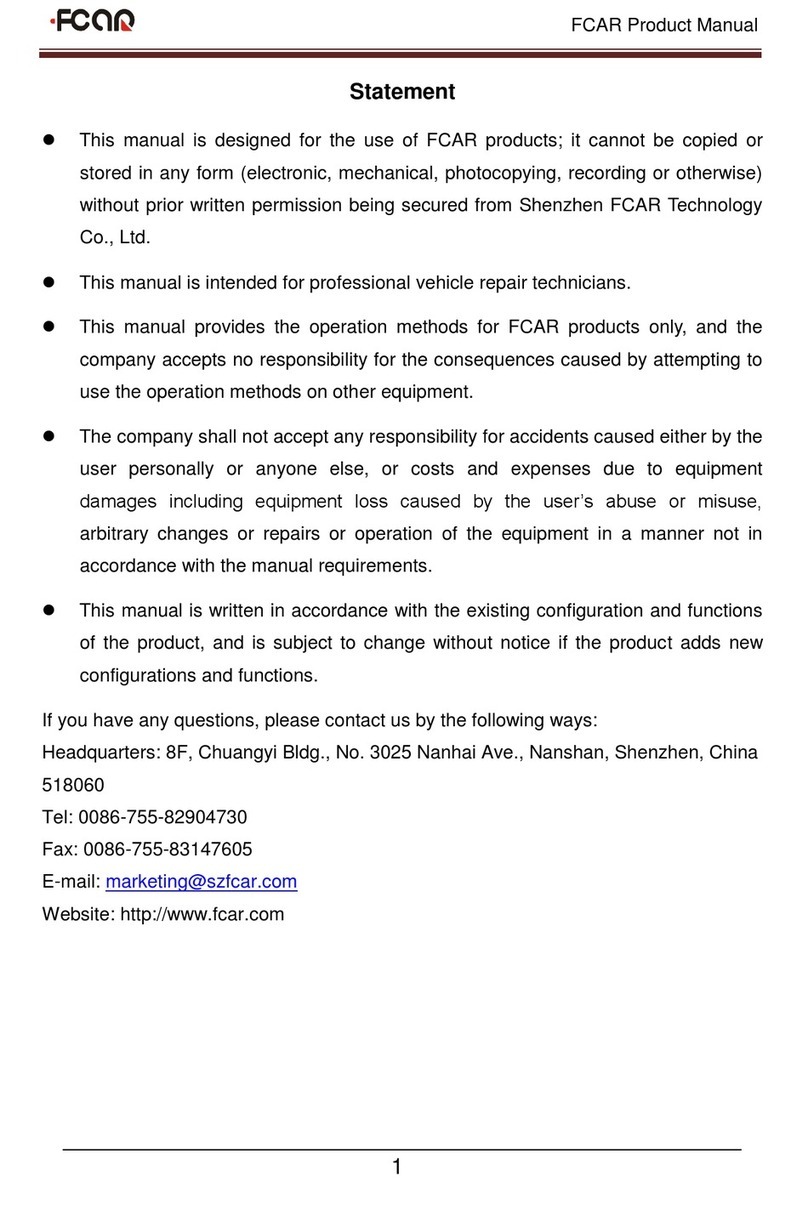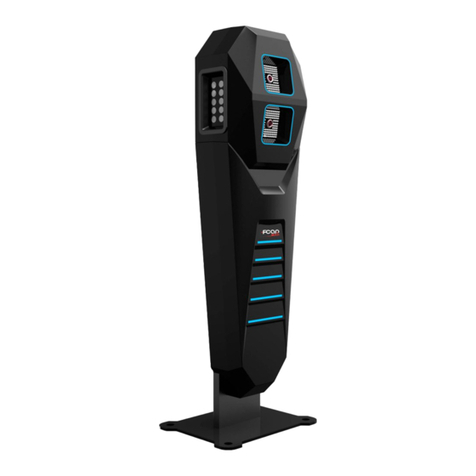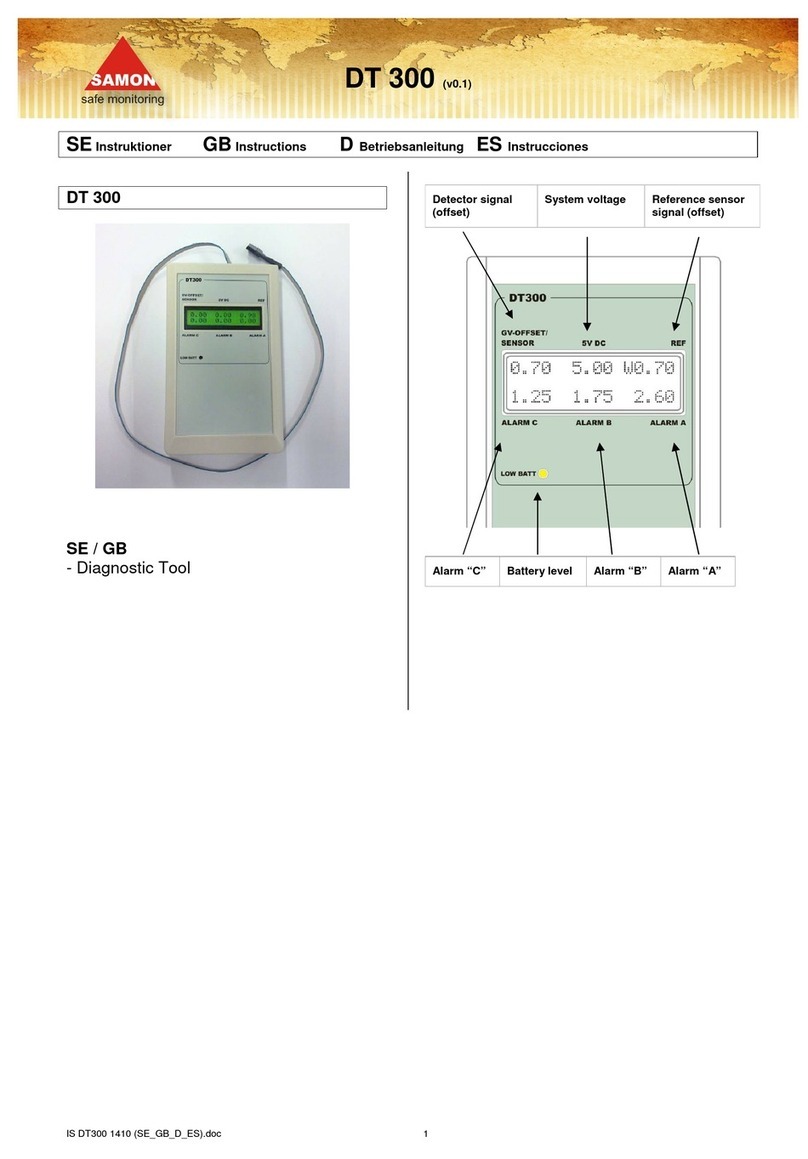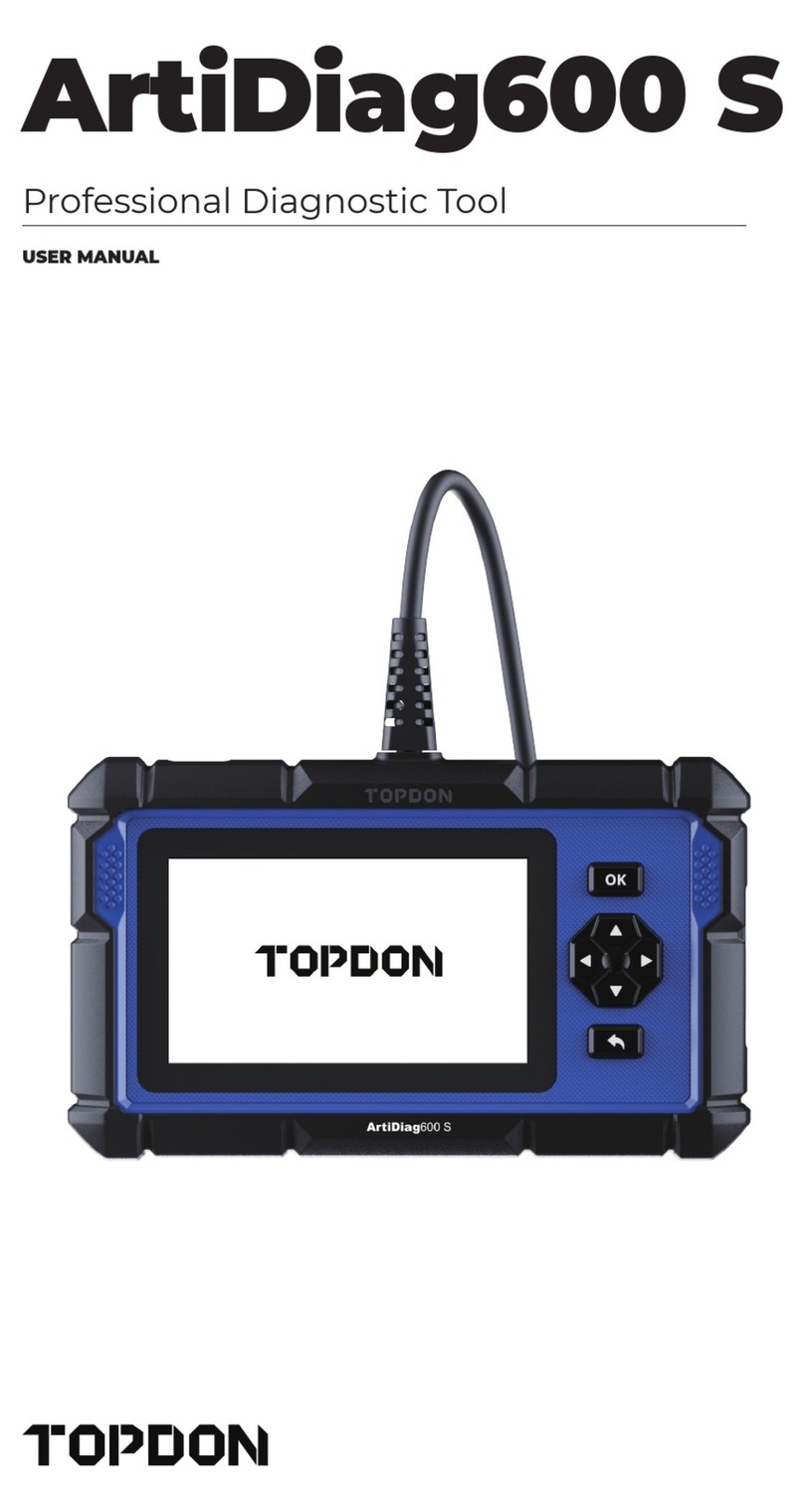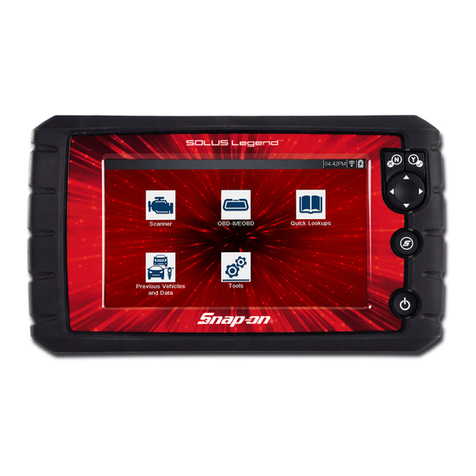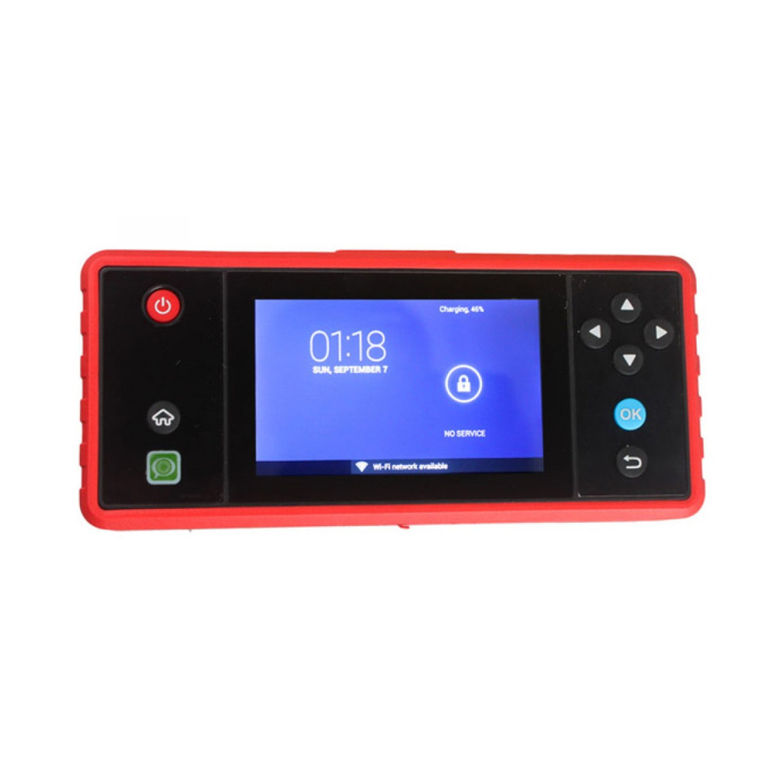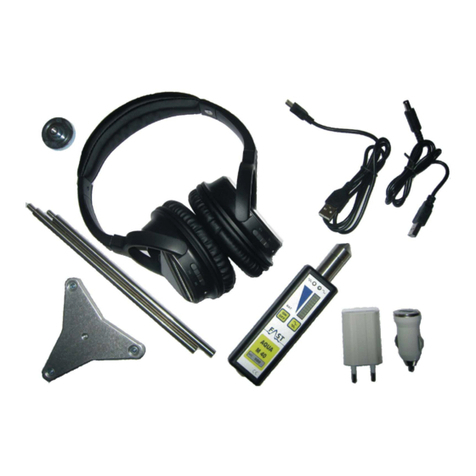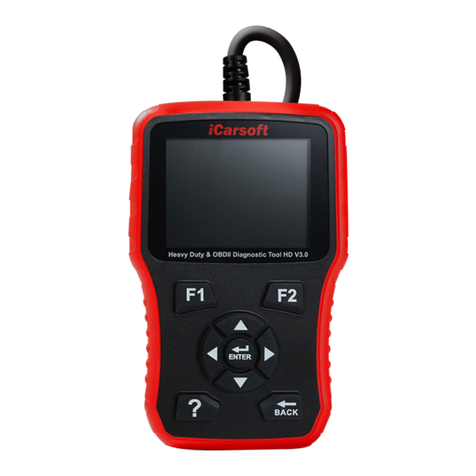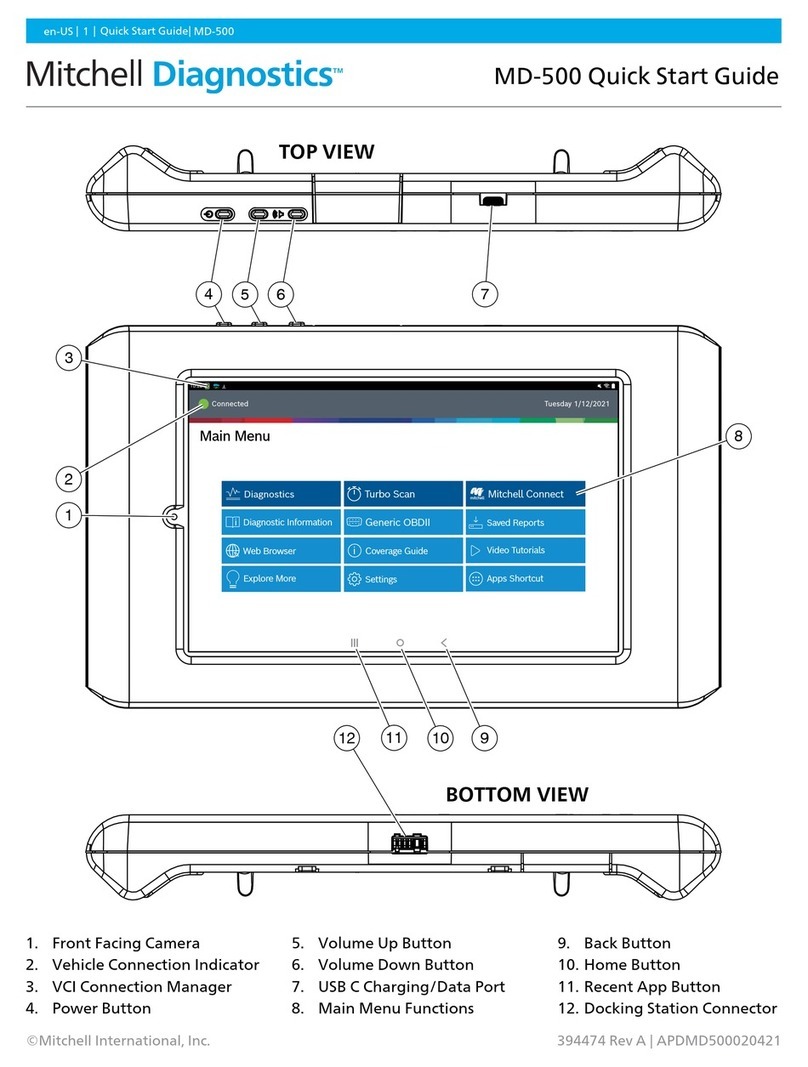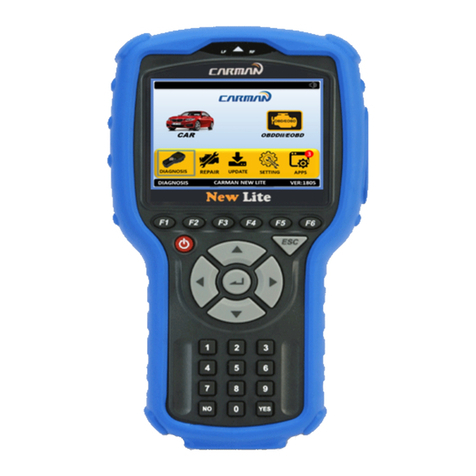Fcar F7S series User manual

FCAR Product Manual
1
Statement
This manual is designed for the use of FCAR products; it cannot be copied or stored
in any form (electronic, mechanical, photocopying, recording or otherwise) without
prior written permission being secured from Shenzhen FCAR Technology Co., Ltd.
This manual is intended for professional vehicle repair technicians.
This manual provides the operation methods for FCAR products only, and the
company accepts no responsibility for the consequences caused by attempting to use
the operation methods on other equipment.
The company shall not accept any responsibility for accidents caused either by the
user personally or anyone else, or costs and expenses due to equipment damages
including equipment loss caused by the user’s abuse or misuse, arbitrary changes or
repairs or operation of the equipment in a manner not in accordance with the manual
requirements.
This manual is written in accordance with the existing configuration and functions
of the product, and is subject to change without notice if the product adds new
configurations and functions.
If you have any questions, please contact us by the following ways:
Headquarters: 8F, Chuangyi Bldg., No. 3025 Nanhai Ave., Nanshan, Shenzhen, China
518060
Tel: 0086-755-82904730
Fax: 0086-755-83147605
E-mail: marketing@szfcar.com
Website: http://www.fcar.com

FCAR Product Manual
2
Registered trademark
The company has registered the trademark in mainland China. The
company declares that the ownership of the registered trademark, service mark, domain
name, logo, and company name in countries in which they have not yet been registered
belongs to the company. Other products and their company name trademarks mentioned
in this manual belong to the original registered company. The trademarks, service marks,
domain names, logos, company names or other companies mentioned may not be used
without prior written permission of the owner.
FCAR Series Host Machine Maintenance and Use Cautions
Do not allow unauthorized disassembly.
Avoid strong impacts to the equipment.
Avoid proximity to any magnetic field.
Do not keep this machine in a high temperature environment for any length of time.
Do not keep this machine in a low temperature environment for any length of time.
Do not forcefully click on the screen or click the screen with sharp tools.
Do not use water and chemical solvents to clean the machine, please use a soft
clean cloth and neutral detergent instead.
Automobile Inspection Notes
Follow the standard safety rules of the auto repair industry to operate. Be especially
careful to avoid impact or damage caused by environmental factors such as the
surrounding pH, poison gas or high pressure environment.
Vehicle battery fluid contains sulfuric acid, which is corrosive to the skin. During
the operation, avoid direct contact with the battery fluid, in particular being careful
not to splash into the eyes. Keep away from fire.
The engine exhaust gas contains a variety of toxic compounds, which one should
avoid breathing in. During the operation, park the vehicle in a well-ventilated place.
When the engine is running, the temperature is very high; please avoid contact with
the water tank, exhaust pipe and other high temperature components.

FCAR Product Manual
3
Before starting the engine, apply the handbrake and place the shift lever in Gear
Neutral (Manual Transmission) or P (Automatic Transmission) to avoid sudden
movements of the vehicle when starting the engine.
Before repairing the vehicle, apply the parking brake, engage the Neutral or P range,
and lower the driver seat’s glass doors.
If the engine can be started, warm-up the vehicle to normal temperature (water
temperature is about 80 °C), and turn off the auxiliary electrical appliances (such as
air conditioning, lighting, sound, etc.).
Find the diagnostic socket of this car; check and confirm the diagnostic socket
cables are in good condition, connecting the main unit for diagnosis. Otherwise, do
not test, to avoid damage to the main unit. If necessary, use a multimeter to
measure the voltage of the diagnostic socket.
Instrument Use Notes
When using FCAR series products for testing, please be gentle and keep them away
from heat and electromagnetic fields, to avoid interference to the main unit.
Do not use sharp tools to click the screen; the matched touch pen is recommended.
When electrical components are energized, do not disconnect the circuit, to prevent
self-inductance and mutual inductance current damaging the sensors and
automotive ECU.
When electrical components are working normally, magnetic objects are forbidden
to approach the automotive control unit, otherwise the vehicle control unit may be
damaged.
Before disassembling the vehicle control unit or electrical components, turn off the
ignition switch for 1 minute.
Do not operate the diagnostic equipment when driving the vehicle, in order to avoid
traffic accident.

FCAR Product Manual
4
CONTENTS
CHAPTER I PRODUCT INTRODUCTION................................................ 6
1.1 INTRODUCTION.........................................................................................6
1.2 F7S HOST STRUCTURE............................................................................ 6
1.3 VCI BOX STRUCTURE.............................................................................. 9
CHAPTER II HOST ON/OFF AND FUNCTION MENU......................... 10
2.1 HOST CHARGING.................................................................................... 10
2.2 BOOTING....................................................................................................11
2.3 SHUTDOWN............................................................................................... 11
2.4 INTRODUCTION TO EACH MENU OPTION......................................11
CHAPTER III VEHICLE DIAGNOSIS......................................................14
3.1 PRE-DIAGNOSTIC TECHNICAL REQUIREMENTS.........................15
3.1.1 EQUIPMENT REQUIREMENTS......................................................... 15
3.1.2VEHICLE REQUIREMENTS................................................................ 15
3.1.3 MAINTENANCE TECHNICIAN REQUIREMENTS..........................15
3.2 VEHICLE CONNECTION........................................................................16
3.2.1 CONNECT VCI BOX TO VEHICLE....................................................16
3.2.2 HOST AND VCI BOX CONNECTION................................................ 18
3.3 VEHICLE TYPE SELECTION................................................................ 20
3.3.1 MANUAL VEHICLE SELECTION......................................................21
3.3.2 AUTO VEHICLE SELECTION............................................................ 21
3.3.3 DIRECT ACCESS TO THE VEHICLE SYSTEM................................ 22
3.3.4 AUTOMATICALLY SCAN VIN CODE............................................... 22
3.3.5 MANUALLY INPUT VIN CODE......................................................... 23
3.3.6 GENERAL OBDII ACCESS MODE.....................................................23

FCAR Product Manual
5
3.4 DIAGNOSIS AND OTHER HIGH-LEVEL FUNCTION...................... 23
3.4.1 MAIN INTERFACE...............................................................................24
3.5 DIAGNOSIS................................................................................................ 25
3.5.1 READ FAULT CODE............................................................................ 27
3.5.2 ERASE FAULT CODE.......................................................................... 27
3.5.3 READ LIVE DATA................................................................................28
3.5.4 ACTUATION TEST............................................................................... 32
3.6 SPECIAL FUNCTION............................................................................... 34
3.7 GENERAL OBDII (FOR GASOLINE MODELS)..................................36
3.8 DEMO ON THE FCAR F7S AND DIAGNOSTIC SOCKET
CONNECTION................................................................................................. 36
3.8.1 ON CONNECTING THE OBD-II CONNECTOR................................36
3.8.2 ON CONNECTING THE NON-OBD-II CONNECTOR....................... 37
3.8.3 CONNECTION BETTWEEN JUMPER HOLDER AND THE
VEHICLE DIAGNOSTIC CONNECTOR..................................................... 37
CHAPTER IV DATA MANAGEMENT...................................................... 43
CHAPTER V REMOTE DIAGNOSIS........................................................ 44
CHAPTER VI REFERENCE....................................................................... 45
CHAPTER VII UPDATE.............................................................................. 45
CHAPTER VIII SETTINGS.........................................................................46
CHAPTER ⅨCOMPLIANCE INFORMATION.....................................51
WARRANTY CLAUSES..................................................................................53

FCAR Product Manual
6
CHAPTER I PRODUCT INTRODUCTION
1.1 INTRODUCTION
FCAR F7S series product is an integrated automotive computer fault diagnostic
instrument aimed at the testing and diagnosis of gasoline, diesel, natural gas and other
electronic control systems. The product is applicable to large and small service
companies, training institutions, automobile manufacturers, repair stations, diesel engine
manufacturers, mining machinery, petrochemical, energy and other enterprises.
Software of F7S is comprehensively configured, and vehicle data and information in it
are authoritative and fully meet the strict requirements of customers' detection breadth
and depth. The software covers thousands of domestic and imported vehicle model data,
and provides a powerful help system with maintenance information, enabling users to
deal with the problems in practical work easily and quickly, thereby increasing the
efficiency and technical level and reflecting the advantage of professional level quality.
1.2 F7S HOST STRUCTURE

FCAR Product Manual
7
Serial
number
Name
Description
①
Power supply indicator
Charge indicator
②
Microphone port
Voice input port
③
Light sensor
Outside light intensity induction
Host parameter
System
Android5.1 multiple task operating system
Processor
Cortex-A17 RK3288 Quad-core processor, 1.8GHz architecture
processor
Touch screen
10.1”Multi touch capacitive screen,TP thickness:1.1mm
Memory
2GB RAM & 32GB ROM,besides supporting 32GB TF memory card
Connection
WiFi &Bluetooth 2.0/4.0
Camera
Rear camera 13 million pixels,supporting Autofocus
Battery
capacity
3.7V/10000mAh
Interface
RJ45, HDMI, USB2.0, TF card slot, Headphone plug, power interface
Size
320*210*30mm

FCAR Product Manual
8
Serial
number
Name
Description
4
TF card slot / 3.5
headphone jack
Storage TF card location / headphone jack
5
Vents
Used to cool the F7S host to avoid overheating
6
External speaker port
For external sound playback
7
Camera
Used to take a photo or record a video
8
Flashing light
Used to provide light when the light is weak
9
DC power port
Used to charge or energize the F7S host
10
RJ45 port
For network connections
11
USB port (Type-B)
Device interface: used to connect to a computer
and use the F7S host as a U disk.
12
USB port
Host interface: used to connect F7S host to the
VCI or connect to the USB flash drive.
13
HDMI port
Standard HDMI interface: used to connect to TV
HD output
14
Power switch
Used to switch on or off F7S host, or lock screen

FCAR Product Manual
9
1.3 VCI BOX STRUCTURE
Serial
number
Name
Description
①
Power supply indicator
Lighted on when the power is supplied
(connected to the car)
②
Diagnostic indicator
Lighted on when communicating with the
vehicle
③
Bluetooth indicator
Lighted on when connected to the F7S Host
machine
④
USB indicator
Lighted on when connected to F7S host

FCAR Product Manual
10
Serial
number
Name
Description
⑤
DB15 port
Connected to the main test cable, and connected to
the vehicle via the diagnostic connector
⑥
USB port (B shape)
Connected to F7S host or used to upgrade the VCI
box
VCI BOX PARAMETERS
Processor
Cortex-M3 Micro controller
Frequency
100MHz
Processor model
LPC1768
Flash EPROM
512KB
Memory
64KB
Bluetooth
Support Bluetooth 2.0, Bluetooth 4.0
CHAPTER II HOST ON/OFF AND FUNCTION MENU
2.1 HOST CHARGING
Host can be charged in following ways:
Power adapter: Plug one end of the AC/DC power adapter to the DC power port of the
host and then connect the other end to the wall socket. The power adapter can be used to
charge the built-in battery pack.

FCAR Product Manual
11
Note: Voltage of the power supply should be within the scope of the product host.
Exceeding the range may cause damage to the product.
2.2 BOOTING
Press and hold the F7S host power switch (about 3 seconds) to power on host, the
following welcome interface will pop up, and then system starts working.
2.3 SHUTDOWN
All vehicle communication must be terminated before shutting down the F7S diagnostic
equipment. Vehicle's electronic control module would go wrong if forced shutdown
during communication, please exit all diagnostic applications before shutting down.
The shutdown steps are as follows:
1) Short press F7S host power switch (about 2 seconds)
2) Click [Shutdown] in the pop-up prompt to close F7S host.
2.4 INTRODUCTION TO EACH MENU OPTION
After the system is powered on, enter the following main menu:

FCAR Product Manual
12
1) Status icon: is the default icon of the standard Android operating system
2) Toolbar (see Table 1 below )
3) Main menu (see Table 2 below)
4) Guide bar (see Table 3 below)
Tip: It is recommended to lock the screen whenever you are not using the device to
protect your system information and save battery power. Slightly click the power/lock
screen button once, the screen will be automatically locked. Excessive force or long press
may cause the button to malfunction or enter the shutdown interface.
Table 1: Toolbar
Icon
Function name
Function description
VCI Connection
VCI box connection and status display (always
available throughout diagnostic operation)
Screenshot
One click to capture the current visual screen
(always available throughout the diagnostic
operation)

FCAR Product Manual
13
Settings
"Settings" function shortcut
Table 2: Main Menu
Icon
Function
name
Function description
Diagnosis
Car diagnostic procedures, see section 3
VCI
connection
Establish and manage communication connections with
VCI devices, see section 3
Data
management
For browsing and managing data files stored, see
section 4
Remote
Run this program to establish remote assistance with
FCAR after-sales technical team, see section 5
Reference
guide
Provide help information such as equipment usage
instructions, maintenance assistance, trouble code
inquiry, etc. See section 6 for details.
Update
Online upgrade of system software, model software,
etc. See section 7 for details.
Settings
Set up and view system information, see section 8 for
details.
Table 3: Guide bar
Icon
Function
name
Function description
Back
Return to last interface
Homepage
Return to the main interface of the Android system

FCAR Product Manual
14
Recently used
program
Display the list of recently-used program thumbnails
list, click on the program thumbnail to open the
program, and swipe up the program thumbnail to close
the program
Website
information
With internet connected, click it to enter FCAR official
website
CHAPTER III VEHICLE DIAGNOSIS
Through having established data connection with the vehicle's electronic control system
that has been connected to the VCI device, the diagnostic program can read vehicle
diagnostic information, check the data stream, and perform actuation test and other
functions.
To establish good communication between the diagnostic program and the vehicle, you
need to do as below:
1) Connect the VCI box to the vehicle diagnostics socket and supply the power;
2) Establish communication between VCI and F7S host via Bluetooth pairing or USB
data cable;
3) Check VCI connection status in the upper right corner of the screen (see 3.2.2). The
vehicle diagnosis can be performed after the connection.
Vehicle diagnosis:
1) Establish a good communication between the diagnostic program and the vehicle
under test, see 3.2
2) Select vehicle type, see 3.3.
3) Perform vehicle diagnosis by “Auto Scan” all systems of the vehicle or manually
selecting and detecting a designated control unit. For details, see 3.5.
Here we make the detailed instructions.

FCAR Product Manual
15
3.1 PRE-DIAGNOSTIC TECHNICAL REQUIREMENTS
3.1.1 EQUIPMENT REQUIREMENTS
F7S series automotive computer fault diagnostics is equipped with a host and various test
connectors when leave factory. In testing, please select appropriate test connector
according to the type of vehicle diagnosis socket.
3.1.2VEHICLE REQUIREMENTS
1) Turn ignition switch to gear ON;
2) Vehicle battery voltage should be between 11~14V or 24~27V (subject to the
vehicle's power supply)
3) Accelerator pedal is in OFF state, that is, the idle coupling point;
4) Ignition timing and idle speed value should be within the standard range, and the
water temperature and transmission oil temperature are in the normal working
temperature (water temperature 90~110°C, transmission oil temperature 50~80°C);
Then, diagnostic cable is connected properly.
3.1.3 MAINTENANCE TECHNICIAN REQUIREMENTS
1) Must have a basic knowledge of automotive electronics;
2) Understand the basic operation methods of this product and familiarize with this

FCAR Product Manual
16
manual;
3) Basically distinguish whether it is a mechanical fault or an electronic control fault
from the vehicle fault phenomenon tested;
4) Learn about the vehicle's origin, year of production, model, engine model and more.
3.2 VEHICLE CONNECTION
3.2.1 CONNECT VCI BOX TO VEHICLE
Before VCI box connected to vehicle, it is necessary to judge whether the diagnostic
socket of the test vehicle is a standard OBD-II port or a non-standard OBD-II port.
1) Vehicles compatible with the OBD-II management system can be connected to
vehicle diagnostics socket and supplied with power only with one standard
OBDII-16 connector;
2) Vehicles that are not compatible with the OBD-II management system need to select
the corresponding connector; some other vehicles need to supply power to the VCI
box through other power sources of the vehicle.
Here we make the operating instruction regards to these two connection modes
Standard OBD-II port connection:
For vehicles that can be connected to standard OBD-II port, you just need to connect
with all-in-one main test cable OBD connector rather than other connectors, as shown in
Figure 3.2-1:

FCAR Product Manual
17
Figure 3.2-1 Connection of standard-OBD-II socket
Instructions:
1) Determine the location and the port of the diagnostic socket;
2) Connect one end of main test cable to DB15 connector of the VCI box and fasten
the fixing bolt;
3) Connect the other end of the main test cable to the vehicle diagnostic socket;
4) At this time, the VCI box is powered by the vehicle diagnostic socket, and the
power indicator light is on.
Note: After test is completed, please rotate the fixing bolts and then gently unplug
the main test cable to avoid damage to the diagnostic port.
NON-OBD-II PORT CONNECTION
For vehicles connected to non-OBD-II interfaces, need to connect the main test cable to
their corresponding dedicated connectors, as shown in Figure 3.2-2:

FCAR Product Manual
18
Figure 3.2-2 Connection of non-OBD-II interface
Instructions:
1) Determine the location, the port, and whether need to be connected to external
power source of diagnostic socket;
2) Connect one end of the main test cable to the DB15 connector of the VCI box and
lock the fixing bolts;
3) Connect the other end of the main test cable to a dedicated adaptor corresponding
to the vehicle;
4) Connect the dedicated connector that is connected to the main test cable to the
vehicle diagnostic socket;
5) At this time, VCI box is powered by the vehicle diagnostic socket, and then power
indicator light is on (if it is not lit, it may be because the vehicle diagnostic socket
is not energized, you can energize the VCI box by the cigarette lighter or the
battery clip).
3.2.2 HOST AND VCI BOX CONNECTION
After VCI box is connected to the vehicle, the connection between the host and the VCI
box needs to be matched, and then vehicle diagnosis can be started after matching is
completed; the VCI box supports two ways of communicating with the F7S host:
Bluetooth pairing and USB cable.

FCAR Product Manual
19
Paired through Bluetooth
1) Turn on F7S host power supply;
2) Select [VCI Connection] in the main menu; select [Bluetooth] in the connection
mode;
3) Click the Scan icon on the right side of the device to automatically scan
Bluetooth devices nearby.
4) Select target Bluetooth to match;
5) When matching is completed, state of VCI icon in the upper right corner of the
screen changes from " " to " ", indicating that the Bluetooth pairing is
successful and the vehicle diagnosis can be started.
Note: If Bluetooth device can't be searched, it is maybe because the signal strength
of the transmitter is too weak. In this case, please move it as close as possible to the
VCI Bluetooth device.
Paired through USB cable connection
USB connection is the fastest communication method between the F7S host and the VCI
device. Please use dedicated USB cable configured by our factory to connect. After the
connection is completed, state of VCI icon in the upper right corner of the screen changes

FCAR Product Manual
20
from “ ” to “ ”. , indicating that the USB connection is successful, and then the
vehicle diagnosis can be started.
Note: These two connection methods can't be used at the same time!
3.3 VEHICLE TYPE SELECTION
When all the above connections are completed, click [Diagnosis] on Main Menu to start
the vehicle diagnosis. The following figure shows the gasoline version of the vehicle
selection interface. The other versions of the model interface are similar.
1) Toolbar (see Table 1 below)
2) Regards to model manufacturer and related detection functions, click on “ ”
in upper right corner of the model to view function list and other related
information of the vehicle type.
3) Asian, European, American major brand vehicle series selection menu
Table 1:
Icon
Name
Function description
Search
One-click search for major brand vehicle types
Other manuals for F7S series
2
Table of contents
Other Fcar Diagnostic Equipment manuals
